List of Authors
>>About this blog
Recent blog post
|
[often slap]
February 28, 2019 16:00
In two times, we are going to go around "the street with the era" passing through Chuo-ku.
In the previous article, we introduced "Heisei-dori" and "Showa-dori".
Today, I would like to go back to the past.
■No. 3 Taisho-dori
By the way, the era before the Heisei and Showa eras is "Taisho era", but unfortunately, the name of "Taisho era street" does not exist in Tokyo.
...However, before the war, there was a street named "Taisho-dori".
And the street passes through Chuo-ku! Click here for the details.
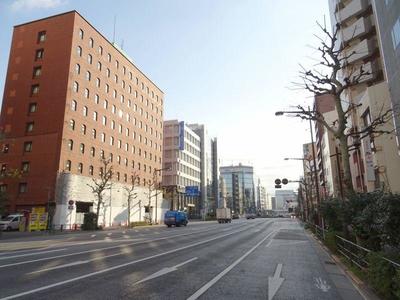
The current name is different, but before the war it was called "Taisho-dori" or "Main Line No. 2".
In the previous article, we introduced that "Showa-dori" was planned as a symbol road for reconstruction after the Great Kanto Earthquake, but in fact, this Showa-dori is "Main Line No. 1".
In contrast to Showa-dori, which runs north and south through Tokyo, Taisho era-dori (main line No. 2) was planned as another symbol road that runs east and west through Tokyo.
Taisho-dori, which connects Shinjuku to Ryogokubashi, is located near the northernmost tip of the ward in Chuo-ku, passing around Bakurocho and Higashinihombashi.
It is 36 meters wide and is less than Showa-dori, but it is a very wide street.
After the war, the Yasukuni Shrine was built near Kudanzaka along the roadside, and Taisho era-dori changed its name to "Yasukuni Dori" and continues to this day. The name of "Taisho-dori" is not currently used, but the street itself is still active.
■Extra 1 “Meiji Dori”
Since it dates back to Heisei, Showa, and Taisho eras, the next is "Meiji-dori St."
Meiji-dori St. in Tokyo starts at Furukawabashi (Minami-Azabu, Minato-ku), passes through the three major subcenters of Shibuya, Shinjuku, and Ikebukuro, and passes through the bases of the outer edge of the city center such as Oji, Minowa, and Kameido. It is a street that connects to the island of Koto-ku.
In other words...From Chuo-ku, it is a route that connects the outside in a ring, and unfortunately does not pass in Chuo-ku.
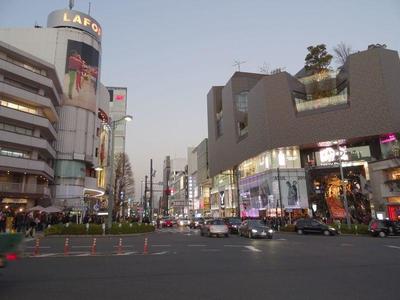
The photo shows the Meiji-dori St. near the Jingumae intersection in Shibuya-ku. According to one theory, it is said that it passed near Meiji-jingu Shrine and became the name of Meiji Dori.
In addition, this road, like Showa-dori and Taisho-dori, is based on the reconstruction city plan after the Great Kanto Earthquake, and is positioned as "No. 5".
■Part 4 "Meijiza Street"
Well, unfortunately, "Meiji-dori St." did not pass through Chuo-ku....、
Is there any other street in the ward with "Meiji"?...When I searched desperately, I found one!
The name is "Meijiza-dori".
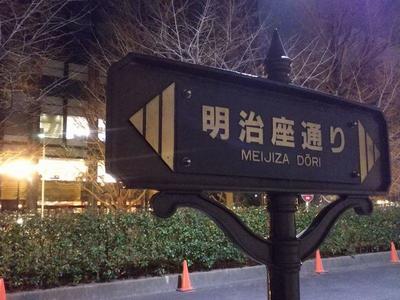
Meijiza, located in Nihonbashihamacho, is a theater with a long history that opened in 1873 as Kishoza. After that, it was renamed "Hisamatsu-za" and "Chitose-za", and in 1893 (Meiji 26), it became the current name "Meijiza". (The frequent problem of Chuo-ku sightseeing certification!)
On the south side of Meijiza, there is a row of ginkgo trees, which is also the entrance to Hamacho Park, but this street is Meijiza Street. The name of the street extends beyond Kiyosubashi Street to Hamacho Ryokudo Park, leading to amazake Yokocho.
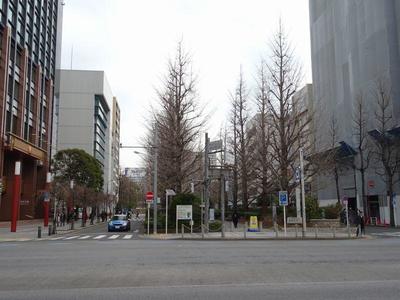
This row of ginkgo trees is lonely at this time, but it is very beautiful in autumn.
By the way, this "Meijiza-dori" is a two-way road across a row of trees, but it is rare in Japan and is somehow on the right side. Maybe you can enjoy a little foreign feeling. It's also true.
■Extra 2 "Edo-dori St."
That's why I was able to find the streets of Heisei, Showa, Taisho era, and Meiji in Chuo-ku, despite some twists. Finally, I would like to introduce another street in the extra edition.
If you call it "● era" in the textbook of history instead of the era, one before Heisei, Showa, Taisho era, and Meiji era is "Edo era".
In fact, "Edo-dori St." also runs in Chuo-ku!
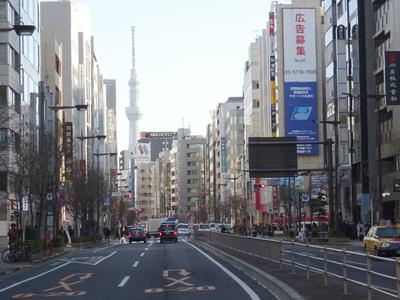
Divided from Chuo-dori at Muromachi 3-chome, proceeded northeast in the ward, crossed Asakusabashi, entered Taito Ward, and ran parallel to the Sumida River to Asakusa, passing through the area that was the first city area of Edo. It is a wonderful street with a place where you can see the Tokyo Sky Tree in the back.
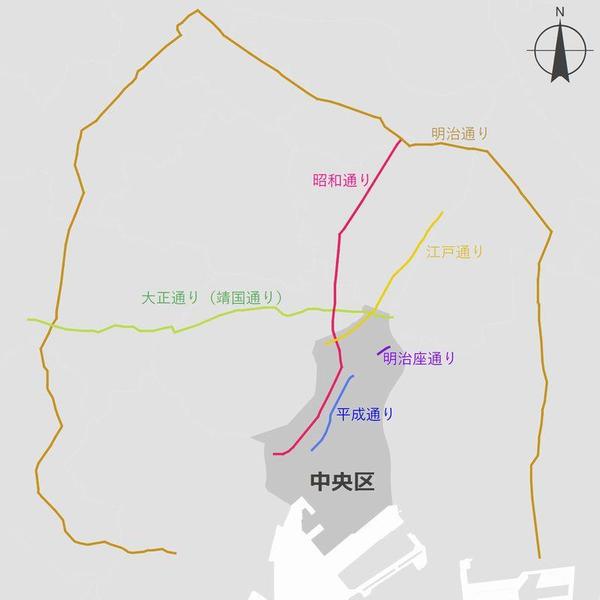
I tried to map the positional relationship of Chuo-ku, as I introduced in the previous article and this article.
(created by the author using the Ministry of Land, Infrastructure, Transport and Tourism's “National Land Price Information” administrative area data and road data.)
In Chuo-ku, from Edo to Heisei, we found that the names of various eras were street names.
In the previous article, I wrote that the origin of "Heisei-dori" is unknown, but the name of "Heisei-dori" was set in 1989, and there is a theory that it may be derived. Can you make a street with the new era somewhere? While expecting, it may be a good memorial to go around the street with the name of the era and era in the last spring of Heisei!
[often slap]
January 30, 2019 09:00
On May 1, this year, the Crown Prince was enthroned as the new Emperor and switched to a new era.
In the streets, "The Last of Heisei"...It was around this time when I often see and hear the word ""
Did you know that there are several streets in Chuo-ku with the name of the era?
Today, of such "the street with the era", those passing through Chuo-ku are passed.
I would like to introduce it in two parts, dating back to Heisei.
■Part 1 "Heisei-dori"
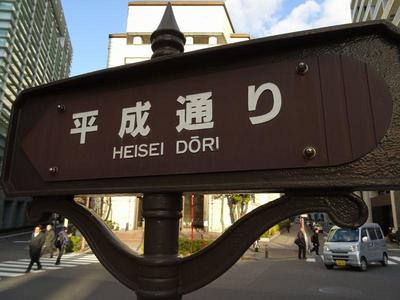
Nihonbashi Kabutocho No.2 (Amibashi Minamizume) 2-15 Tsukiji (intersection with Harumi-dori St.)
It's a street running parallel to the west side of Shin-ohashi-dori St.
I don't know why it became the name "Heisei-dori"...。
(I would like somebody to explain to you!)
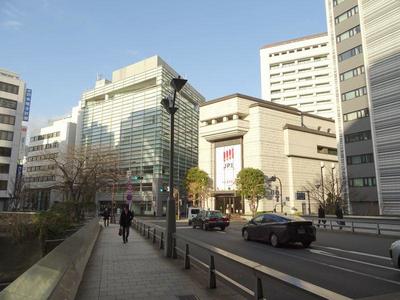 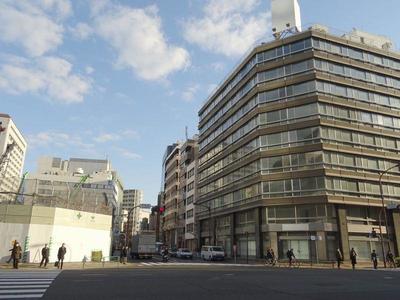
In Kabuto-cho and Kayabacho near the starting point, the Tokyo Stock Exchange (Photo 1) and the Tokyo Stock Exchange (Photo 1).
In addition to the auxiliary shrine Hie-jinja Shrine, it reminds me of the period of high economic growth.
Office buildings (second photo) are lined up.
If anything, there is a taste of "Showa", but it is also a taste of "Showa".
Redevelopment of the area has begun beyond the era of Heisei.
I feel the flow of the times.
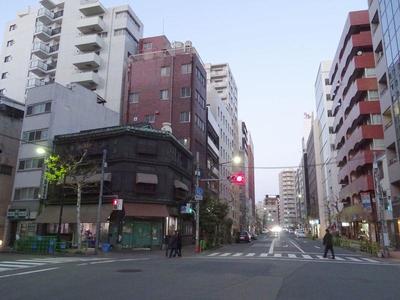
Tsukiji near the end point is also the Historic buildings selected by Tokyo.
There is a building of "Miyakawa Shokutori Chicken Egg" (built in 1929).
In addition, there are historic sites along the road, such as the site of Shintomiza and the site of Hoshu Katsuragawa Yashiki.
While saying "Heisei", it has become a way to have various eras.
■No. 2 Showa-dori
Connecting Shimbashi (Shimbashi 1, Minato-ku) to Ozeki Yokocho (5, Negishi, Taito-ku).
It is a wide street between Shimbashi and Ueno, including in Chuo-ku.
It runs parallel to the east side of Chuo-dori.
The Heisei-dori just mentioned is parallel across the Metropolitan Expressway.
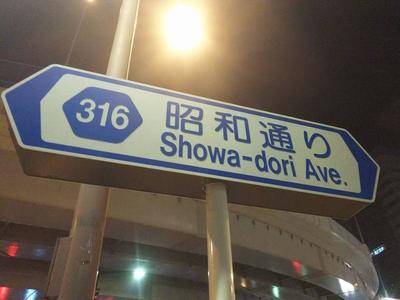 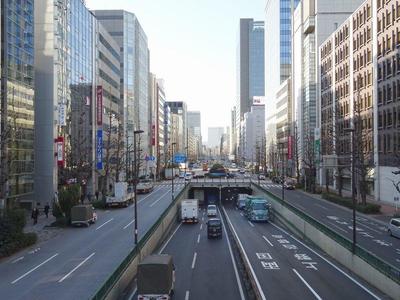
This road was constructed after the Great Kanto Earthquake that occurred in 1923 (Daisho 12).
This symbol road was created as a centerpiece of reconstruction city planning.
In 1931 (Showa 6), when the era was just changed to Showa.
Since it was completed, it was nicknamed "Showa-dori".
It was a street that symbolized the new era of Showa.
Its wide width (44 meters) has plenty of street tree belts and sidewalks.
It is also a remnant planned as a park street.
(By the way, at the beginning of the concept, it was planned with a width of 108 meters.
It's more than twice the current width!)
Looking for an old photo in the library, when it was completed, it was between the upper and lower lanes.
It seems that there were two rows of trees and sidewalks. (Partial as parking lots)
It seems to have been used.
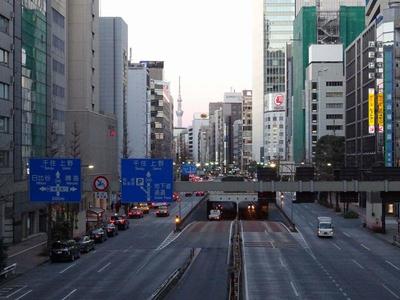 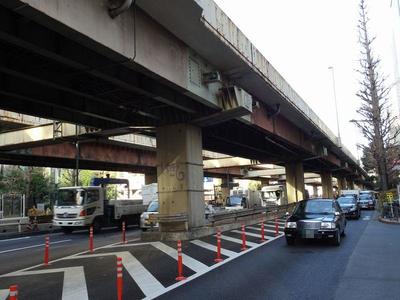
The current figure is a section with three or more lanes one way, an underpass dedicated to passing traffic underneath.
In the north of Edobashi, the underground parking lot connected from there is an overpass of the Metropolitan Expressway overhead....
The structure emphasizes functional aspects, handling a large amount of automobile traffic as an aorta in the city center.
In a sense, it has become a road that symbolizes the Showa era, especially the post-war era.
Nowadays, it is often thought that there are no sights or highlights just because there are many streets.
This Showa-dori is located along the Nihonbashi Post Office (the birthplace of mail), a monument derived from Betta City, and a monument derived from the city.
Historic sites such as the ruins of Kano Art Juku and like the Nihonbashi Diamond Building (formerly Edobashi Warehouse Building).
In addition to the famous buildings
In Nihonbashi Honmachi, there are Ozu Historical Museum and Daiichi Sankyo Medicine Museum.
There is also a spot.
If you walk separately from Heisei-dori and Showa-dori from the viewpoint of street, you can see that you can walk around.
There seems to be a different kind of fun again!
By the way, next time I would like to go back to the Taisho era.
Some people think, "There is no Taisho-dori!?"
Actually, when you go back to the past, there was also Taisho-dori in Chuo-ku.
I'm looking forward to it!
[often slap]
January 3, 2019 14:00
The Ningyocho Shopping Street, which runs from Ningyocho Station to Suitengumae Station, is located in Ningyocho Shopping Street.
Every year, during the year-end and New Year holidays, lanterns are served along the street.
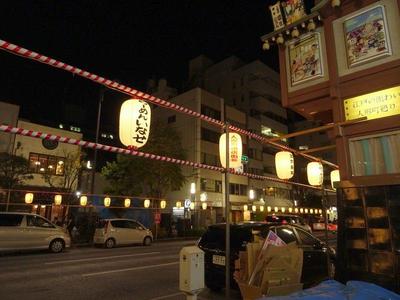
At night, the warm lanterns illuminate the streets and create a wonderful atmosphere.
Is it like an illumination that looks like a downtown area in Edo?
Ningyocho-dori is a street where you can enjoy various changes in outfits throughout the year, but I like this year-end and New Year lantern decoration best.
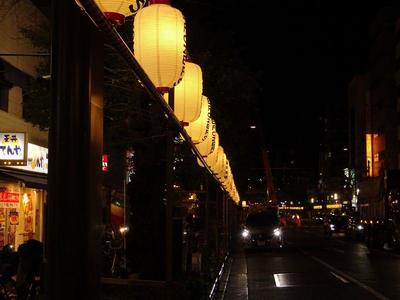
Lanterns line up at the entrance of "Daikanonji".
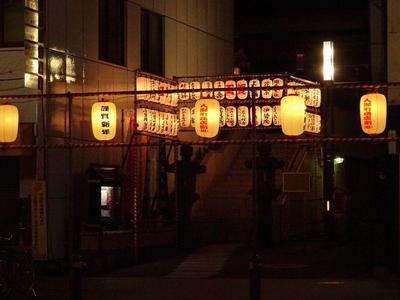
At the end of the year, Ningyocho-dori will become a “Toshinoichi” and there will be stalls selling Shinto straw festoon decorations. (Note: 2018 has already ended.)
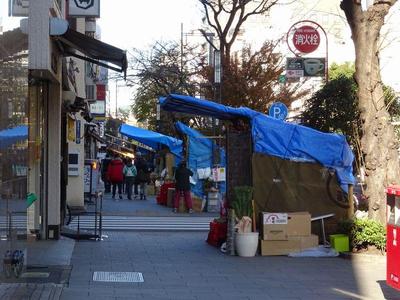
In this season, besides Toshinoichi, you can hear the voices of the town council's `` Beware of Fire '' and the sound of claps, and `` Torichika '' and `` Torichu '' who are famous for egg grilling Many people come to make reservations, and on weekday nights, there are many people returning from the year-end party, and the city of Ningyocho is full with the end of the year. And at the beginning of the year it will be a different crowd of people in new year worshipping.
In any case, it is a season when you feel that the various activities of those who live, work, and visitors in this city are shaped like this "lively lively". I would like to work hard as a correspondent next year as a tourist association so that I can well convey the charm of Chuo-ku's “lively lively”
[often slap]
December 1, 2018 12:00
From Chuo-ku government office (1-1 Tsukiji), walk along the Metropolitan Expressway toward Shiodome.... At the base of the celebration bridge, you can see a building with a somewhat strange presence.

There are many ways to call this building, but it is "Old Dentsu Headquarters Building" (1-11 Tsukiji).
As the name implies, the building was headquartered until the advertising agency Dentsu moved to Shiodome in 2002.
The building was completed in 1967 by Kenzo Tange, a leading architect in Japan, and was designed by Kenzo Tange.
This building, in fact, was part of a very grand concept.
Kenzo Tange created a master plan called the Tsukiji Redevelopment Plan in 1964, three years before the completion of this building.
<Reference> Image of Tsukiji Redevelopment Plan
https://www.tangeweb.com/works/works_no-32/
(I fly to the homepage of Tange City Architecture Design)
The Tsukiji Redevelopment Plan is a grand concept that connects large-scale buildings to create a city like a single system.
Each building has a structure that allows the building to freely extend in height and lateral directions according to demand.
(By the way, Mr. Tange is also famous for proposing the concept of "Tokyo Plan 1960" that allows the city to extend to the sea on a larger scale.)
The former Dentsu headquarters building was originally planned to be part of this magnificent system.
The design has been changed due to construction costs, etc., and the original plan is slightly different from the actual construction.
Looking at the side of the building, you can see that it expresses the nature of "extending more and more" as seen in the Tsukiji Redevelopment Plan.
(Please see the photo below!)
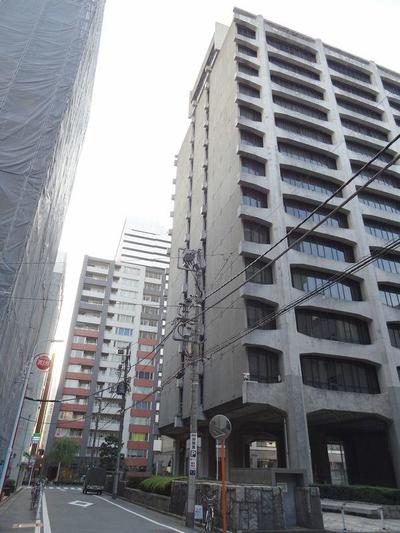
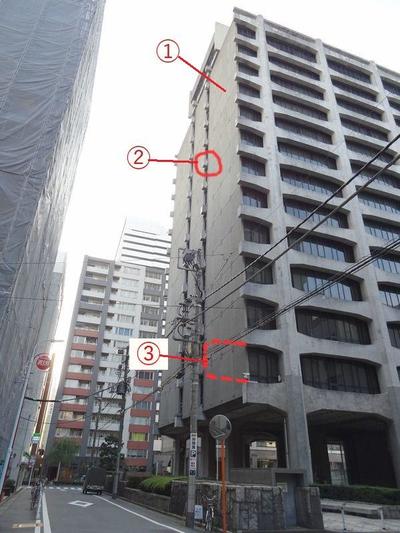
① Inorganic walls with few windows that indicate that they are "cross-sections" on the way instead of the "surface" of the building.
② The beams are popping out a little, and it's going to extend it.
③ The window frame is cut off at half of a unit!
If you look like this, the building looks like it's really growing and it's interesting.
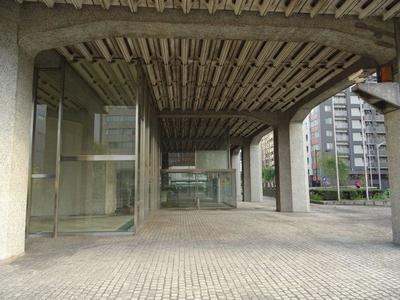
Although it is such an old Dentsu headquarters building, it is also characterized by the use of materials such as concrete and metal, and the finish of industrial products pursuing functionality. Then, the space without walls and pillars on the first floor can be seen by the influence of the French master Le Corbusier's idea of "liberating architecture from the ground." These are characteristics found in Modernism architecture.
This building is also one of the first cases in which a system called "specific block" was applied.
...Until then, the height of buildings was limited to 31 meters (approximately 100 feet) in large cities in Japan, except for a few exceptions, but the height restrictions were abolished due to the progress of building technology and high economic growth. In 1961, a system called "special block" was established in which heights can be set only within the block, and Japan's first skyscraper building, "Kasumigaseki Building" was linked to the building. The former Dentsu headquarters building is one of the first projects that were designated as a specific block on the same day as the Kasumigaseki Building.
It is about 60m high and is not a rare height in Tokyo now, but at the time of its completion, it would have symbolized Japan's rapid economic growth and the rise of urban areas in Tokyo.
The former Dentsu headquarters building, which conveys the architectural tide and social situation at that time, is now an empty building and we have heard rumors that rebuilding is planned soon.
If you go to think about the air feeling 50 years ago, it is now
[often slap]
October 31, 2018 09:00
Hello!
Today, I would like to jump out of Chuo-ku and deliver it from Tokyo International Airport (Hada Airport).
In this "Chuo-ku sightseeing correspondent blog", in principle, information about Chuo-ku is to be sent.
Why did you pick up Haneda Airport in Ota-ku?
That's because there is a replica of Nihonbashi, one of Chuo-ku's identity, in Haneda Airport.
The name is "Haneda Nihonbashi". It is located in the International Terminal Building, which started operation in 2010.
After arriving at the international terminal by train, monorail, or bus, you will arrive at the departure lobby on the third floor.
You can see something like that in the direction of the left back. Go up to the 4th floor by escalator and go in that direction ...
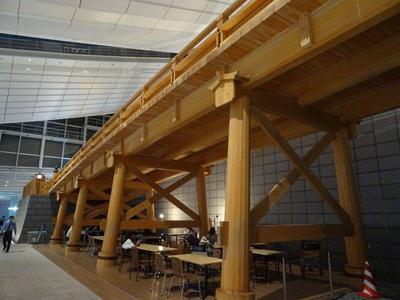
You can see "Haneda Nihonbashi". Under the bridge, tables and chairs are placed to create a rest space.
The replica of Nihonbashi is modeled on a wooden Nihonbashi in the late Edo period and the first half of the 19th century, instead of the stone-built Nihonbashi that is currently built, and cypress from Yoshino is used. (By the way, Nihonbashi in the late Edo period seems to have been using cypress and zelkova.)
The width and length are reproduced in about half the size (4m x 25m).
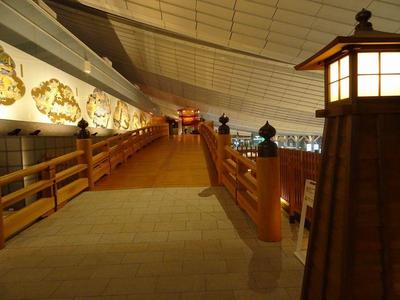
You can use stairs and elevators to climb on the bridge.
Wooden lanterns are also placed, creating a Japanese atmosphere in a modern design terminal building.
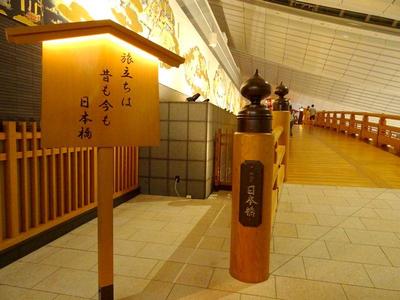
"The departure has been in Nihonbashi for a long time and now."...It is a word that I want to keep in mind as a sightseeing correspondent in Chuo-ku
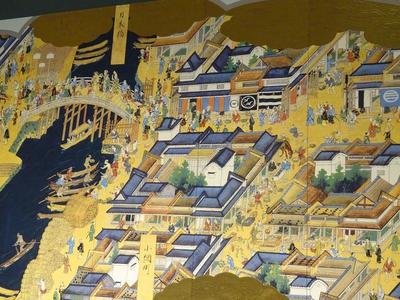
One side of the bridge is a wall, and a replica of the huge "Edo Figure Screen" is displayed.
The main towns of Edo during the establishment period are depicted, including Nihonbashi, Kyobashi / Shimbashi, Hatchobori / Tsukiji, and many towns in the current Chuo-ku. .
The photo is a part of Nihonbashi.
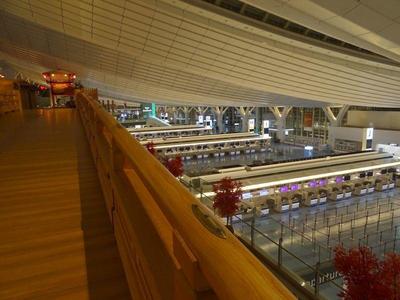
The opposite side of the "Edo-zu folding screen" has a good view, and you can see the departure lobby of the International Terminal Building.
Of course, it is far from the actual scenery seen from Nihonbashi....Laugh
You can enjoy the feeling of having slipped in time!
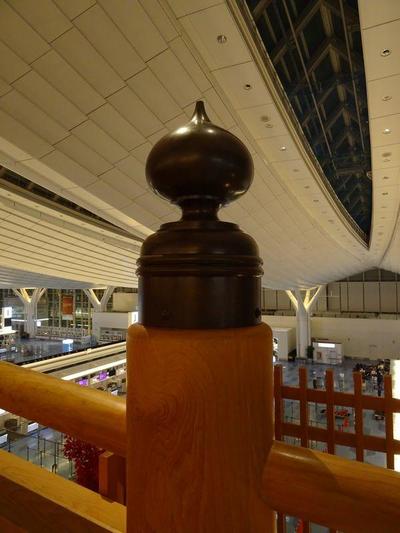
In addition, the "giboshi" shaped like an onion and the "hoju pillar" supporting it are reproduced in actual size.
By the way, the way from the departure lobby to "Haneda Nihonbashi" is called "Edokoji".
It is a shopping area inspired by the streets of the Edo period.
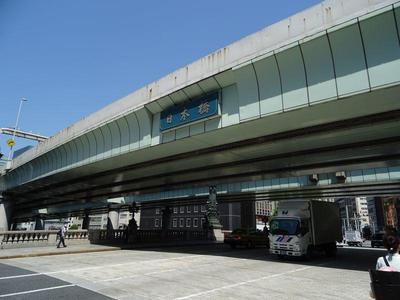
By the way, in addition to the "Haneda Nihonbashi" introduced this time, the "Edo Tokyo Museum" in Sumida-ku also has a replica of Nihonbashi from the Edo period, but all of them are reproduced only half in length....
The actual scale of Nihonbashi can only be experienced locally!
From Haneda Airport to Nihonbashi, you can take a direct train from Keikyu Line to Toei Asakusa Line without having to change trains.
Experience the texture of Nihonbashi in the Edo period at "Haneda Nihonbashi", think about the scenery of Chuo-ku in the Edo period with "Edo Figure Screen", and then stand on Nihonbashi....Such a trip may be interesting!
[often slap]
September 30, 2018 12:00
Hello! Today, I would like to report on the last tuna auction tour of Tsukiji Market!
As you all know, the Tokyo Metropolitan Central Wholesale Market Tsukiji Market in Tsukiji, Chuo-ku will close at the end of October 6 this year, and its function will move to Toyosu Market in Koto-ku.
Meanwhile, the tour of the tuna auction, which has become popular among foreign tourists in recent years, ended on September 15th.
I wanted to go to the tour once before the closing, so I heard the last information on September 15 and rushed in.
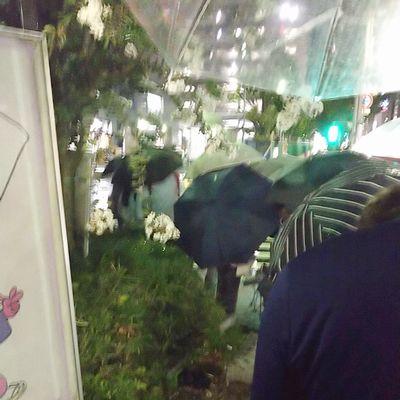
By the way, the tuna auction tour is divided into two groups around 6:00 am, and the tour is accepted at 5:00 am.
It is not a pre-reservation system, so if you want to visit, you need to wait in front of 5:00 in the morning, it is quite hard.
However, I started to line up on this day at 23:00 pm on the 14th the day before! ・... I really wanted to go to the tour on the morning of the 14th, so I visited around 4 o'clock in the morning, but on that day, "The people who lined up at 2 o'clock in the morning reached the capacity, so the reception was closed I failed to challenge ... "The last day will be closed when the date changes ...!"
When I entered the line, about 20 people were already lined up. While it rains, hold your umbrella and wait still.
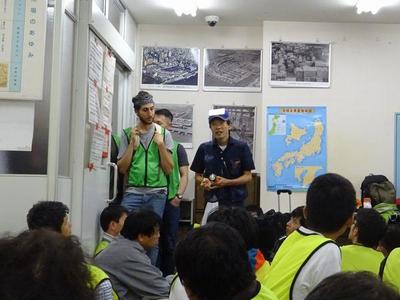
After a while after the date changed, the number of people lined up increased, so the reception started and I had them pass through the room of the facility.
After that, I wait at the physical education seat and light up the night. It was good because I was able to survive the rain, but it was a very good training.
Perhaps it was 4:00 am, a wholesaler came to explain the tuna auction in Tsukiji Market. There are many foreigners, so the explanation is English. I answered English questions exactly in English, and they responded wonderfully!
After that, I finally leave the room before six in the morning. When I went out, it was quite bright.
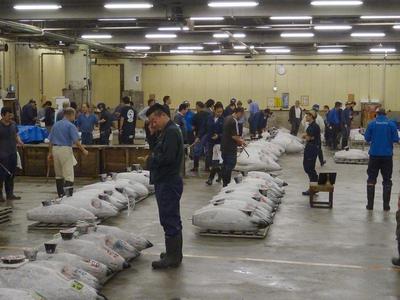
After entering the building of the racetrack, it was finally a long-awaited tour.
Inside, I was able to see the frozen tuna lined up in a row in the same space up close.
And over time, buyers gathered one after another.
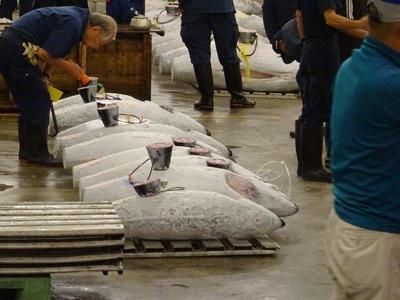
You can see something in a conical shape on each tuna, but this is a cut off the tail to check the quality of the tuna, and buyers use this part with a Kama to check the quality. Shake the body and pick it up or illuminate it with a flashlight to check the quality.
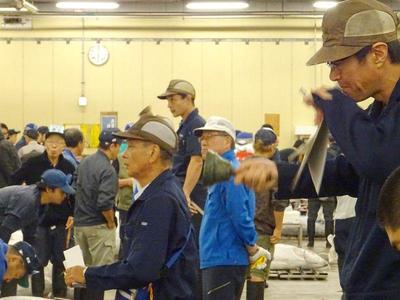
After 6 o'clock, when the seller ringed the bell, the auction began, and voices shouting at prices all over the venue were heard. The auction progressed steadily while showing the price with your fingers, so I couldn't keep up as a general visitor, but I was able to experience a unique atmosphere.
According to what I heard, a tuna auction tour will be held at Toyosu Market, where the relocation site is located. However, it seems that there will be a passage and space dedicated to visitors, so it is undeniable that the tour can be done safely and with little trouble, but it will be "from outside". It was a very valuable experience to be able to visit the auction site from the inside at Tsukiji!
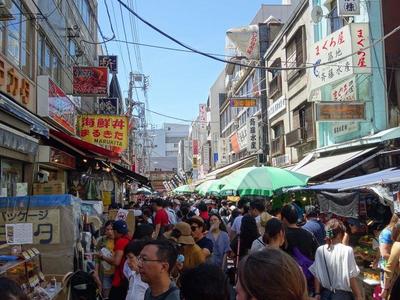
By the way, Tsukiji Market will close soon, but the city of Tsukiji itself should be enjoyed in the future! I think so.
The Tsukiji Outer Market, which was formed around the Tsukiji Market, remains at its current location, and is powering up by adding Ningro's Tsukiji Fish Bank. I think it will not only continue to be a place for buyers to purchase, but also serve as a base for disseminating Japanese food culture to those who come to sightseeing. (The photo shows the Tsukiji Outer Market.)
In addition, the city of Tsukiji has many other attractions besides the market. Tsukiji Honganji Temple, which has a unique main hall that combines ancient Indian style and Japanese temple architecture style, prewar wooden architecture that remains in various places, and many historical sites related to Christianity in Akashicho.
|
Links
|




































